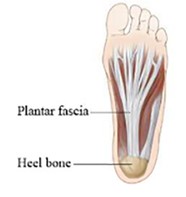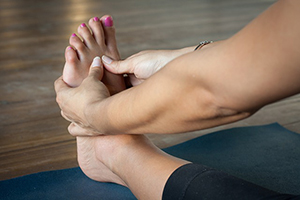Plantar Fasciitis
By Scott Meier, MD, KP Sports Medicine Elk Grove

What is the Plantar Fascia and what is Plantar Fasciitis?
The plantar fascia is a thick tissue on the bottom of the foot that connects the heel bone to the base of the toes. This is helps support the arch of the foot and stabilize the structures around the bottom of the foot. Plantar fasciitis is a painful condition that involves inflammation and/or small tears of this tissue. The pain is often felt when pressure is placed on the bottom of the foot with standing, walking, running, or other similar motion.
What Causes Plantar Fasciitis?
Any one or a combination of stresses to this area can cause plantar fasciitis. It has been affiliated with increased walking, standing, stair-climbing or running that can occur with a new job or starting a new fitness program. It can also occur with increasing intensity or frequency of use in a job or workout program that is higher than the healing rate. It has also been associated with performing activity on a different terrain or surface than used prior. Other factors that have led to plantar fasciitis include having tight calf muscles, using high heels, being overweight or by having an arch that is not properly supported throughout the day. Another common cause is using a shoe with exercise that has worn out and no longer supports the foot sufficiently.
What are the Symptoms?
The main symptom is pain on the bottom of the foot, usually near the heel. Pain can worsen with weight bearing activity, especially first thing in the morning when getting out of bed. This pain can improve as the day progresses with simple use, but often will hurt with higher intensity use.
How is it Treated?
The best way to treat plantar fasciitis is to give it proper rest. The tears or micro tears of this tissue need to be given time to heal completely. Combinations of ice, NSAIDs, supportive shoes or inserts can help with this process.
Ice is often used either in an ice bath, placing an ice pack on the foot or rolling a frozen water bottle on the bottom of the foot. Finding the right shoe to support the arch varies for all foot types, so be sure to seek out help if needed and know that a couple types of inserts or shoes may need to be tried before you find the right combination.
Walking barefoot without support may also contribute to delayed healing. If this pain persists, despite these adjustments, then you should seek advice from your physician or a specialist. They can help clarify if the above treatments need any adjusting and they may also suggest other options including physical therapy or more aggressive treatment like a boot, stiff shoe or crutches to allow this to heal.
Other items that could be tried for continued pain may include a night splint, a cortisone injection or rarely this can progress to surgery. All of the possible causes (see above) should be considered both for treatment and when returning back to activity after healing. The goal should be to both help resolve this issue, but also control the stresses on this area to prevent it from returning.

